Applied Microeconomics: Market Power, Regulation, and Bank Performance
VerifiedAdded on 2023/06/13
|19
|4260
|377
Essay
AI Summary
This essay examines the dynamics within the Australian financial sector, focusing on the interplay between competition, regulation, and bank performance. It references an article highlighting the views of the Productivity Commission regarding the impact of regulatory capital on bank returns on equity (ROE). The essay discusses the oligopolistic nature of the Australian banking sector, dominated by the 'big four' banks, and explores the potential for monopolistic trends and their implications on customer welfare. It also touches upon the benefits of a competitive market and the trade-offs between stricter regulations aimed at preventing negative externalities and their potential repercussions on competition and efficiency. The essay further delves into the socialist calculation debate and its relevance to the financial sector, ultimately concluding on the need for a balanced approach that promotes both stability and competition within the industry. Desklib provides access to similar essays and study resources for students.
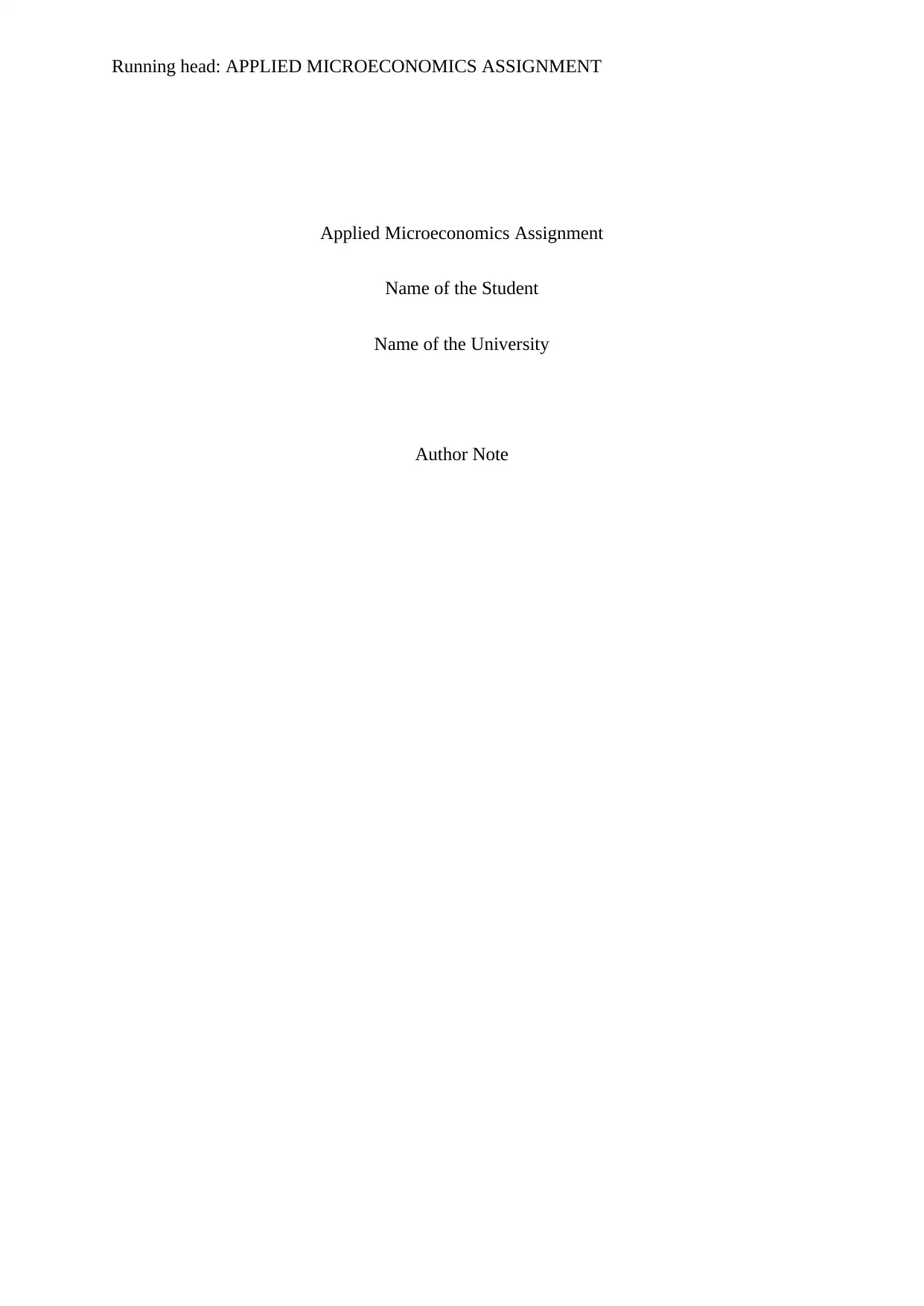
Running head: APPLIED MICROECONOMICS ASSIGNMENT
Applied Microeconomics Assignment
Name of the Student
Name of the University
Author Note
Applied Microeconomics Assignment
Name of the Student
Name of the University
Author Note
Paraphrase This Document
Need a fresh take? Get an instant paraphrase of this document with our AI Paraphraser
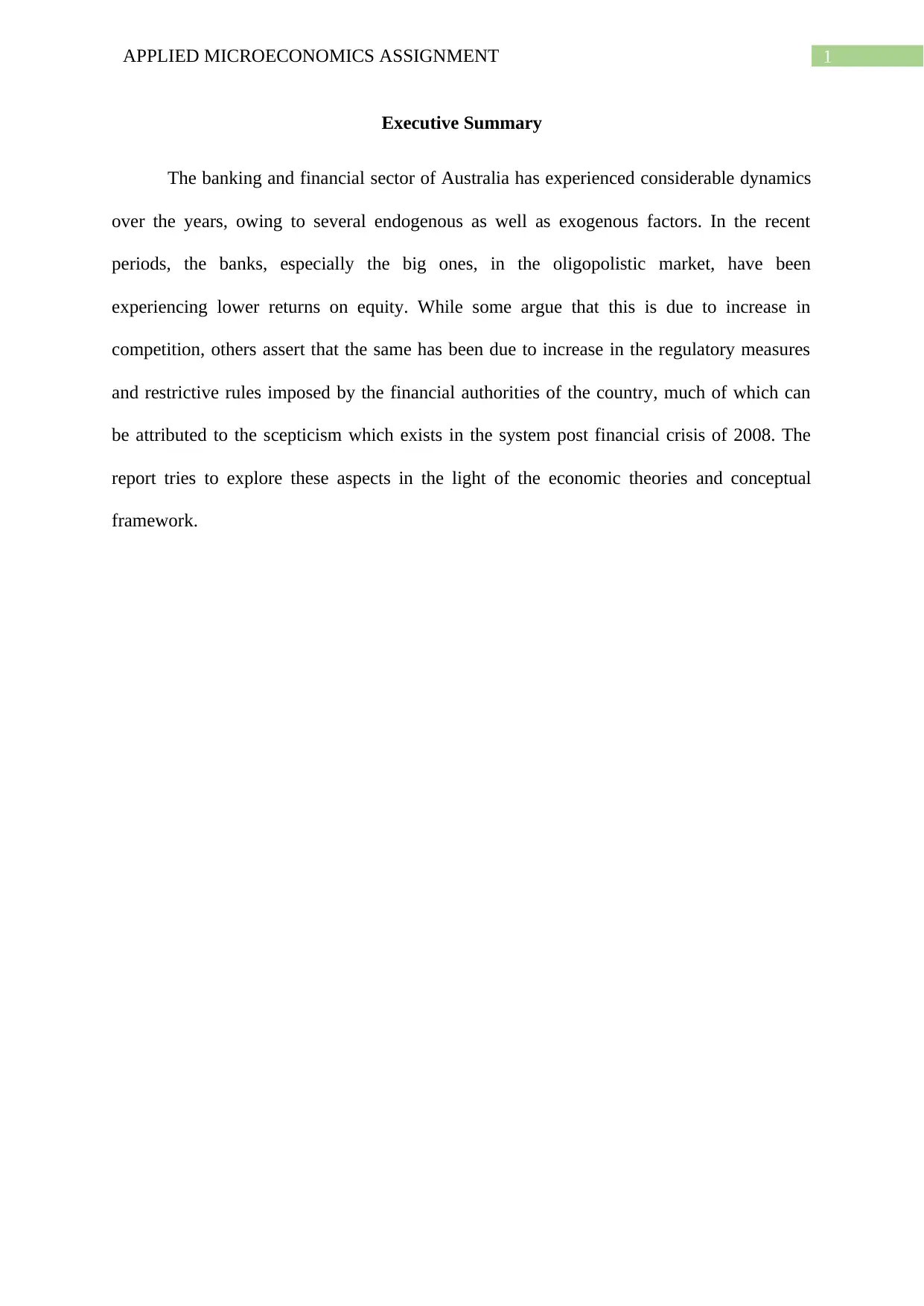
1APPLIED MICROECONOMICS ASSIGNMENT
Executive Summary
The banking and financial sector of Australia has experienced considerable dynamics
over the years, owing to several endogenous as well as exogenous factors. In the recent
periods, the banks, especially the big ones, in the oligopolistic market, have been
experiencing lower returns on equity. While some argue that this is due to increase in
competition, others assert that the same has been due to increase in the regulatory measures
and restrictive rules imposed by the financial authorities of the country, much of which can
be attributed to the scepticism which exists in the system post financial crisis of 2008. The
report tries to explore these aspects in the light of the economic theories and conceptual
framework.
Executive Summary
The banking and financial sector of Australia has experienced considerable dynamics
over the years, owing to several endogenous as well as exogenous factors. In the recent
periods, the banks, especially the big ones, in the oligopolistic market, have been
experiencing lower returns on equity. While some argue that this is due to increase in
competition, others assert that the same has been due to increase in the regulatory measures
and restrictive rules imposed by the financial authorities of the country, much of which can
be attributed to the scepticism which exists in the system post financial crisis of 2008. The
report tries to explore these aspects in the light of the economic theories and conceptual
framework.
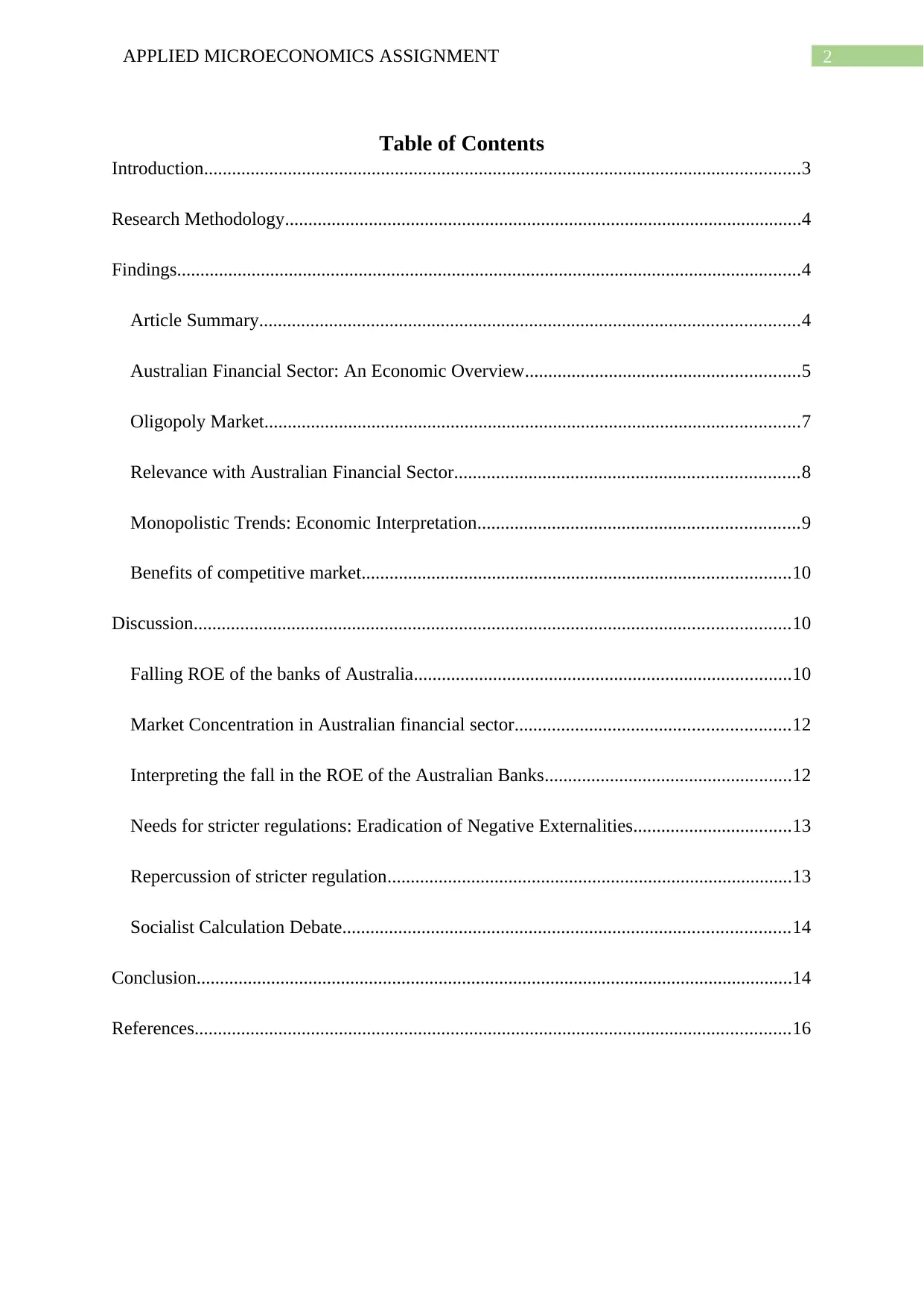
2APPLIED MICROECONOMICS ASSIGNMENT
Table of Contents
Introduction................................................................................................................................3
Research Methodology...............................................................................................................4
Findings......................................................................................................................................4
Article Summary....................................................................................................................4
Australian Financial Sector: An Economic Overview...........................................................5
Oligopoly Market...................................................................................................................7
Relevance with Australian Financial Sector..........................................................................8
Monopolistic Trends: Economic Interpretation.....................................................................9
Benefits of competitive market............................................................................................10
Discussion................................................................................................................................10
Falling ROE of the banks of Australia.................................................................................10
Market Concentration in Australian financial sector...........................................................12
Interpreting the fall in the ROE of the Australian Banks.....................................................12
Needs for stricter regulations: Eradication of Negative Externalities..................................13
Repercussion of stricter regulation.......................................................................................13
Socialist Calculation Debate................................................................................................14
Conclusion................................................................................................................................14
References................................................................................................................................16
Table of Contents
Introduction................................................................................................................................3
Research Methodology...............................................................................................................4
Findings......................................................................................................................................4
Article Summary....................................................................................................................4
Australian Financial Sector: An Economic Overview...........................................................5
Oligopoly Market...................................................................................................................7
Relevance with Australian Financial Sector..........................................................................8
Monopolistic Trends: Economic Interpretation.....................................................................9
Benefits of competitive market............................................................................................10
Discussion................................................................................................................................10
Falling ROE of the banks of Australia.................................................................................10
Market Concentration in Australian financial sector...........................................................12
Interpreting the fall in the ROE of the Australian Banks.....................................................12
Needs for stricter regulations: Eradication of Negative Externalities..................................13
Repercussion of stricter regulation.......................................................................................13
Socialist Calculation Debate................................................................................................14
Conclusion................................................................................................................................14
References................................................................................................................................16
⊘ This is a preview!⊘
Do you want full access?
Subscribe today to unlock all pages.

Trusted by 1+ million students worldwide
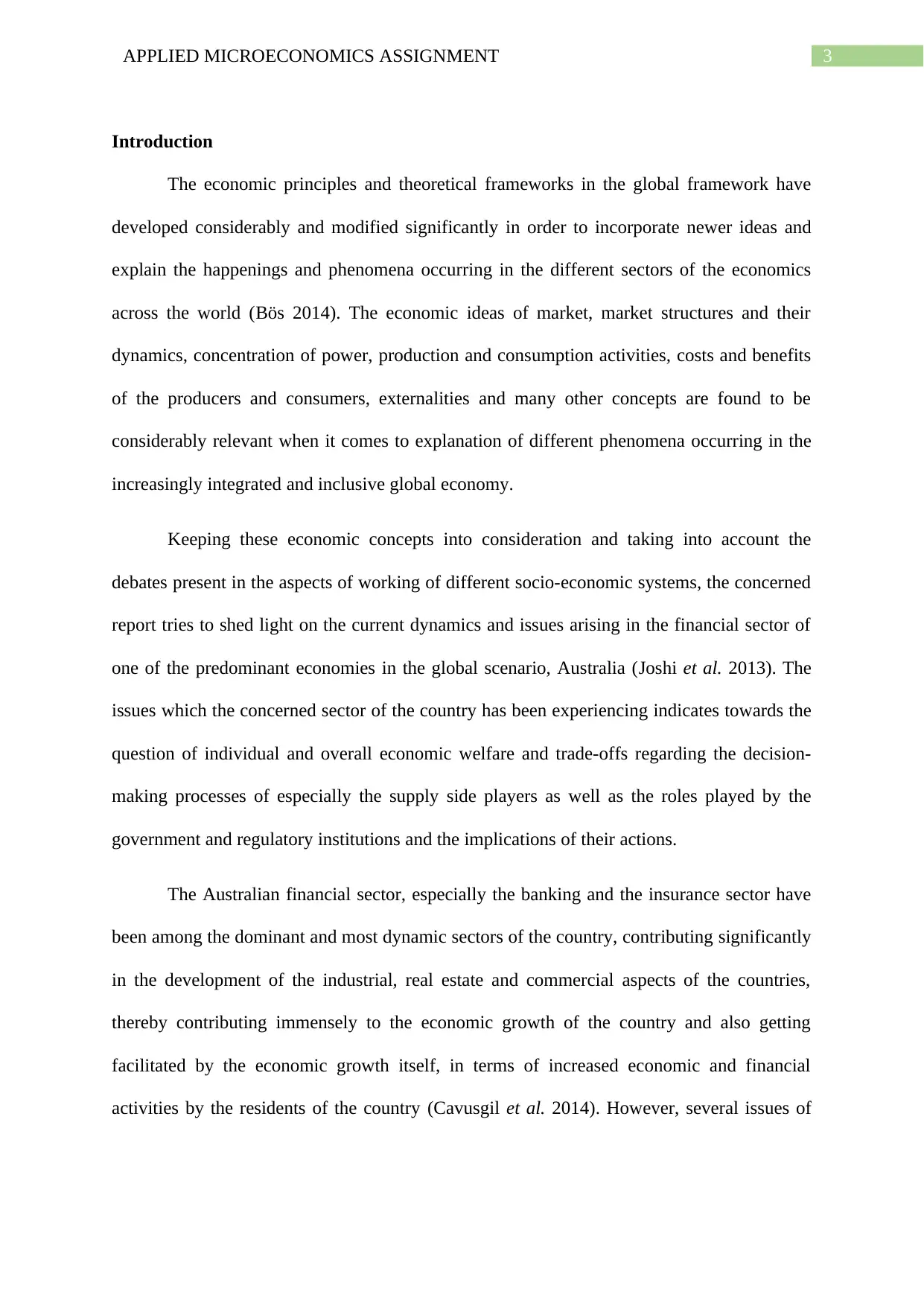
3APPLIED MICROECONOMICS ASSIGNMENT
Introduction
The economic principles and theoretical frameworks in the global framework have
developed considerably and modified significantly in order to incorporate newer ideas and
explain the happenings and phenomena occurring in the different sectors of the economics
across the world (Bös 2014). The economic ideas of market, market structures and their
dynamics, concentration of power, production and consumption activities, costs and benefits
of the producers and consumers, externalities and many other concepts are found to be
considerably relevant when it comes to explanation of different phenomena occurring in the
increasingly integrated and inclusive global economy.
Keeping these economic concepts into consideration and taking into account the
debates present in the aspects of working of different socio-economic systems, the concerned
report tries to shed light on the current dynamics and issues arising in the financial sector of
one of the predominant economies in the global scenario, Australia (Joshi et al. 2013). The
issues which the concerned sector of the country has been experiencing indicates towards the
question of individual and overall economic welfare and trade-offs regarding the decision-
making processes of especially the supply side players as well as the roles played by the
government and regulatory institutions and the implications of their actions.
The Australian financial sector, especially the banking and the insurance sector have
been among the dominant and most dynamic sectors of the country, contributing significantly
in the development of the industrial, real estate and commercial aspects of the countries,
thereby contributing immensely to the economic growth of the country and also getting
facilitated by the economic growth itself, in terms of increased economic and financial
activities by the residents of the country (Cavusgil et al. 2014). However, several issues of
Introduction
The economic principles and theoretical frameworks in the global framework have
developed considerably and modified significantly in order to incorporate newer ideas and
explain the happenings and phenomena occurring in the different sectors of the economics
across the world (Bös 2014). The economic ideas of market, market structures and their
dynamics, concentration of power, production and consumption activities, costs and benefits
of the producers and consumers, externalities and many other concepts are found to be
considerably relevant when it comes to explanation of different phenomena occurring in the
increasingly integrated and inclusive global economy.
Keeping these economic concepts into consideration and taking into account the
debates present in the aspects of working of different socio-economic systems, the concerned
report tries to shed light on the current dynamics and issues arising in the financial sector of
one of the predominant economies in the global scenario, Australia (Joshi et al. 2013). The
issues which the concerned sector of the country has been experiencing indicates towards the
question of individual and overall economic welfare and trade-offs regarding the decision-
making processes of especially the supply side players as well as the roles played by the
government and regulatory institutions and the implications of their actions.
The Australian financial sector, especially the banking and the insurance sector have
been among the dominant and most dynamic sectors of the country, contributing significantly
in the development of the industrial, real estate and commercial aspects of the countries,
thereby contributing immensely to the economic growth of the country and also getting
facilitated by the economic growth itself, in terms of increased economic and financial
activities by the residents of the country (Cavusgil et al. 2014). However, several issues of
Paraphrase This Document
Need a fresh take? Get an instant paraphrase of this document with our AI Paraphraser
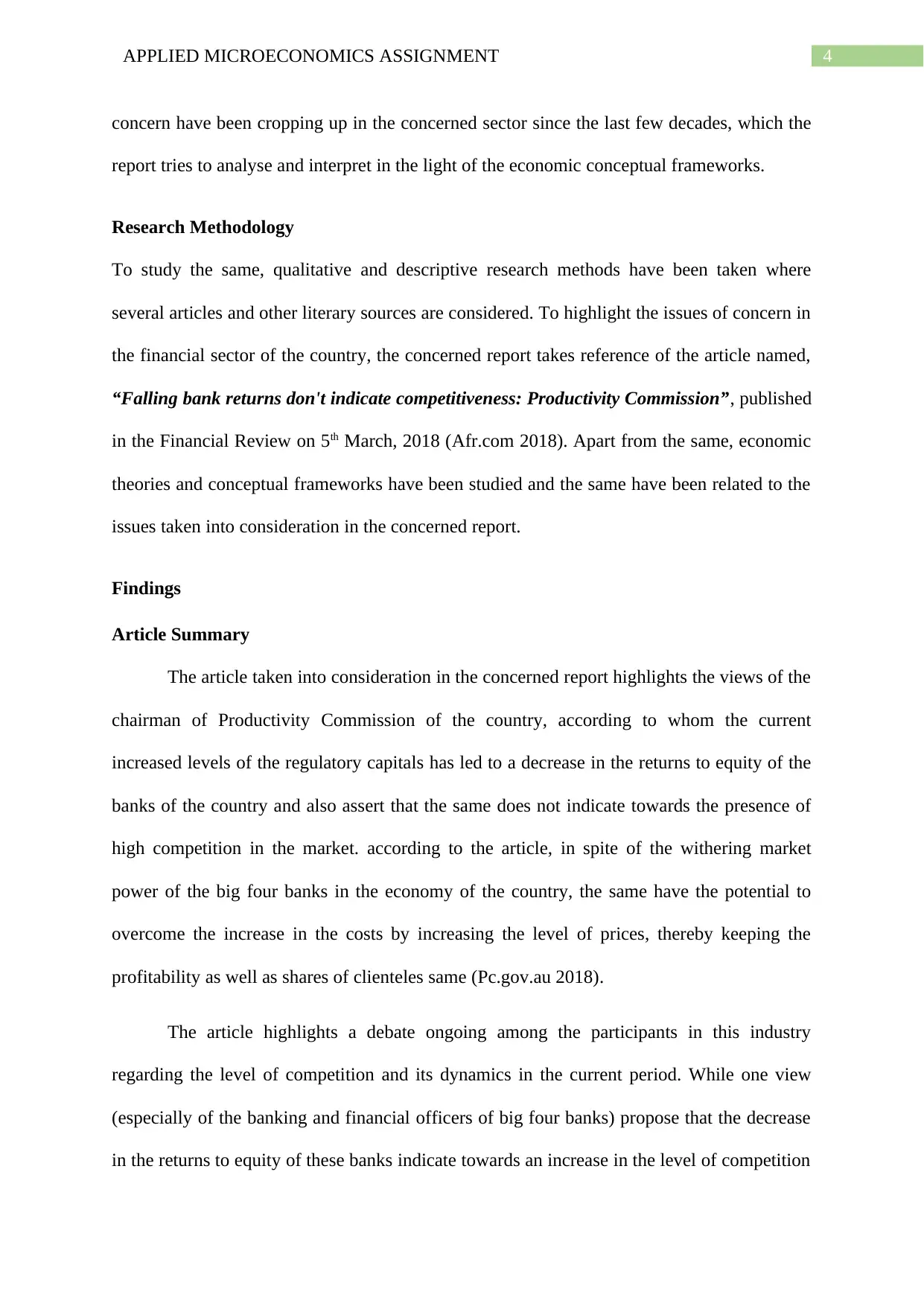
4APPLIED MICROECONOMICS ASSIGNMENT
concern have been cropping up in the concerned sector since the last few decades, which the
report tries to analyse and interpret in the light of the economic conceptual frameworks.
Research Methodology
To study the same, qualitative and descriptive research methods have been taken where
several articles and other literary sources are considered. To highlight the issues of concern in
the financial sector of the country, the concerned report takes reference of the article named,
“Falling bank returns don't indicate competitiveness: Productivity Commission”, published
in the Financial Review on 5th March, 2018 (Afr.com 2018). Apart from the same, economic
theories and conceptual frameworks have been studied and the same have been related to the
issues taken into consideration in the concerned report.
Findings
Article Summary
The article taken into consideration in the concerned report highlights the views of the
chairman of Productivity Commission of the country, according to whom the current
increased levels of the regulatory capitals has led to a decrease in the returns to equity of the
banks of the country and also assert that the same does not indicate towards the presence of
high competition in the market. according to the article, in spite of the withering market
power of the big four banks in the economy of the country, the same have the potential to
overcome the increase in the costs by increasing the level of prices, thereby keeping the
profitability as well as shares of clienteles same (Pc.gov.au 2018).
The article highlights a debate ongoing among the participants in this industry
regarding the level of competition and its dynamics in the current period. While one view
(especially of the banking and financial officers of big four banks) propose that the decrease
in the returns to equity of these banks indicate towards an increase in the level of competition
concern have been cropping up in the concerned sector since the last few decades, which the
report tries to analyse and interpret in the light of the economic conceptual frameworks.
Research Methodology
To study the same, qualitative and descriptive research methods have been taken where
several articles and other literary sources are considered. To highlight the issues of concern in
the financial sector of the country, the concerned report takes reference of the article named,
“Falling bank returns don't indicate competitiveness: Productivity Commission”, published
in the Financial Review on 5th March, 2018 (Afr.com 2018). Apart from the same, economic
theories and conceptual frameworks have been studied and the same have been related to the
issues taken into consideration in the concerned report.
Findings
Article Summary
The article taken into consideration in the concerned report highlights the views of the
chairman of Productivity Commission of the country, according to whom the current
increased levels of the regulatory capitals has led to a decrease in the returns to equity of the
banks of the country and also assert that the same does not indicate towards the presence of
high competition in the market. according to the article, in spite of the withering market
power of the big four banks in the economy of the country, the same have the potential to
overcome the increase in the costs by increasing the level of prices, thereby keeping the
profitability as well as shares of clienteles same (Pc.gov.au 2018).
The article highlights a debate ongoing among the participants in this industry
regarding the level of competition and its dynamics in the current period. While one view
(especially of the banking and financial officers of big four banks) propose that the decrease
in the returns to equity of these banks indicate towards an increase in the level of competition
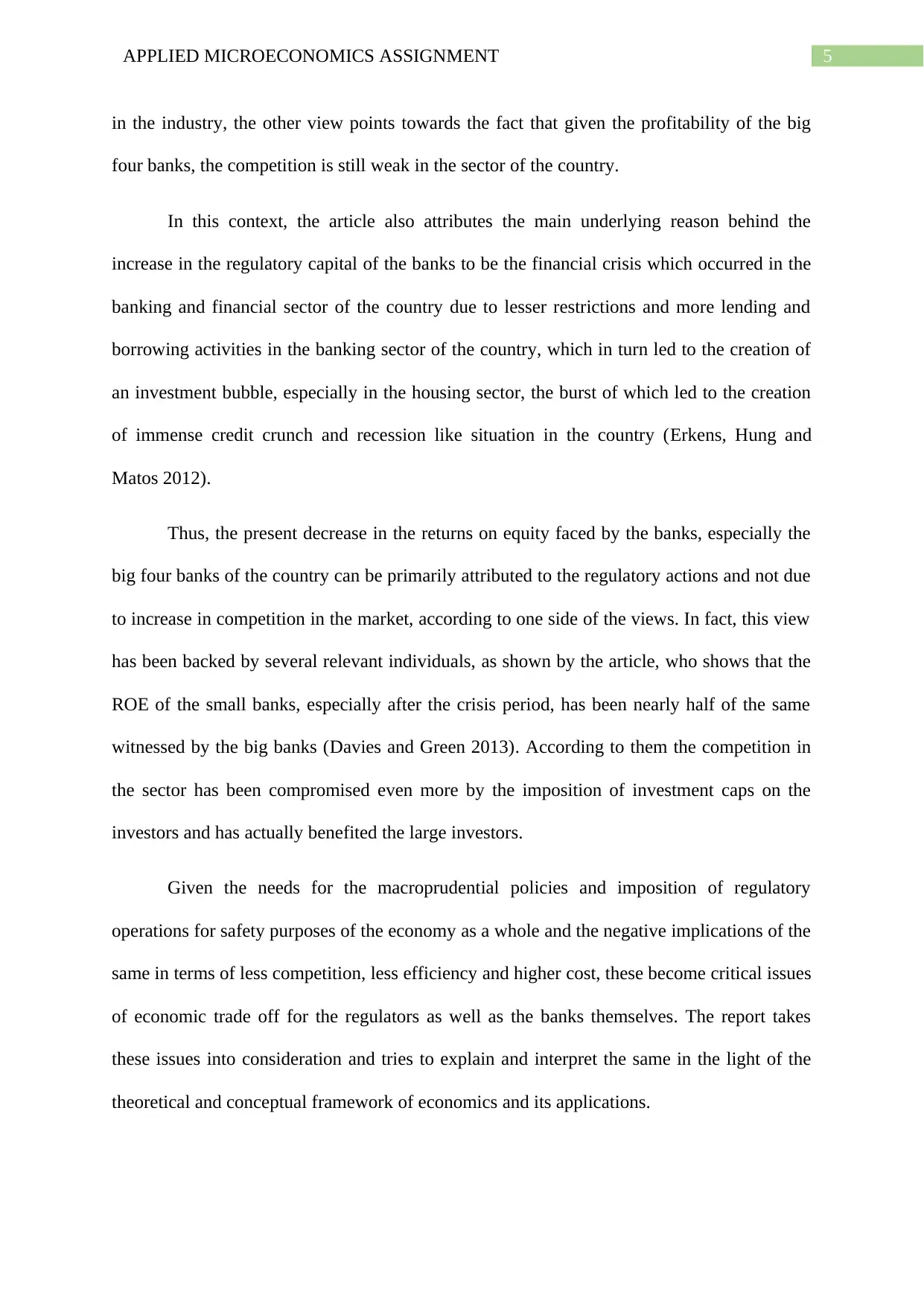
5APPLIED MICROECONOMICS ASSIGNMENT
in the industry, the other view points towards the fact that given the profitability of the big
four banks, the competition is still weak in the sector of the country.
In this context, the article also attributes the main underlying reason behind the
increase in the regulatory capital of the banks to be the financial crisis which occurred in the
banking and financial sector of the country due to lesser restrictions and more lending and
borrowing activities in the banking sector of the country, which in turn led to the creation of
an investment bubble, especially in the housing sector, the burst of which led to the creation
of immense credit crunch and recession like situation in the country (Erkens, Hung and
Matos 2012).
Thus, the present decrease in the returns on equity faced by the banks, especially the
big four banks of the country can be primarily attributed to the regulatory actions and not due
to increase in competition in the market, according to one side of the views. In fact, this view
has been backed by several relevant individuals, as shown by the article, who shows that the
ROE of the small banks, especially after the crisis period, has been nearly half of the same
witnessed by the big banks (Davies and Green 2013). According to them the competition in
the sector has been compromised even more by the imposition of investment caps on the
investors and has actually benefited the large investors.
Given the needs for the macroprudential policies and imposition of regulatory
operations for safety purposes of the economy as a whole and the negative implications of the
same in terms of less competition, less efficiency and higher cost, these become critical issues
of economic trade off for the regulators as well as the banks themselves. The report takes
these issues into consideration and tries to explain and interpret the same in the light of the
theoretical and conceptual framework of economics and its applications.
in the industry, the other view points towards the fact that given the profitability of the big
four banks, the competition is still weak in the sector of the country.
In this context, the article also attributes the main underlying reason behind the
increase in the regulatory capital of the banks to be the financial crisis which occurred in the
banking and financial sector of the country due to lesser restrictions and more lending and
borrowing activities in the banking sector of the country, which in turn led to the creation of
an investment bubble, especially in the housing sector, the burst of which led to the creation
of immense credit crunch and recession like situation in the country (Erkens, Hung and
Matos 2012).
Thus, the present decrease in the returns on equity faced by the banks, especially the
big four banks of the country can be primarily attributed to the regulatory actions and not due
to increase in competition in the market, according to one side of the views. In fact, this view
has been backed by several relevant individuals, as shown by the article, who shows that the
ROE of the small banks, especially after the crisis period, has been nearly half of the same
witnessed by the big banks (Davies and Green 2013). According to them the competition in
the sector has been compromised even more by the imposition of investment caps on the
investors and has actually benefited the large investors.
Given the needs for the macroprudential policies and imposition of regulatory
operations for safety purposes of the economy as a whole and the negative implications of the
same in terms of less competition, less efficiency and higher cost, these become critical issues
of economic trade off for the regulators as well as the banks themselves. The report takes
these issues into consideration and tries to explain and interpret the same in the light of the
theoretical and conceptual framework of economics and its applications.
⊘ This is a preview!⊘
Do you want full access?
Subscribe today to unlock all pages.

Trusted by 1+ million students worldwide
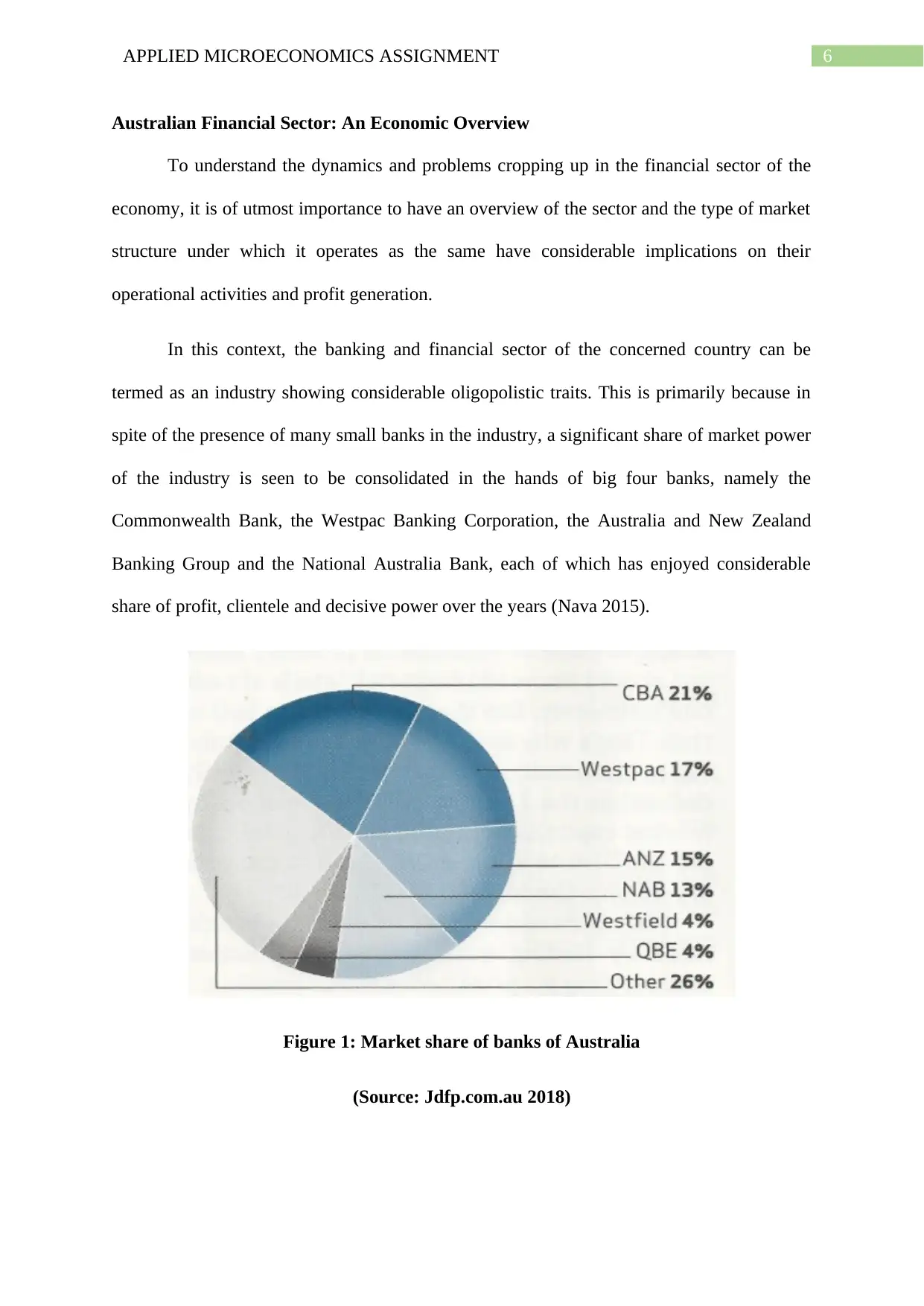
6APPLIED MICROECONOMICS ASSIGNMENT
Australian Financial Sector: An Economic Overview
To understand the dynamics and problems cropping up in the financial sector of the
economy, it is of utmost importance to have an overview of the sector and the type of market
structure under which it operates as the same have considerable implications on their
operational activities and profit generation.
In this context, the banking and financial sector of the concerned country can be
termed as an industry showing considerable oligopolistic traits. This is primarily because in
spite of the presence of many small banks in the industry, a significant share of market power
of the industry is seen to be consolidated in the hands of big four banks, namely the
Commonwealth Bank, the Westpac Banking Corporation, the Australia and New Zealand
Banking Group and the National Australia Bank, each of which has enjoyed considerable
share of profit, clientele and decisive power over the years (Nava 2015).
Figure 1: Market share of banks of Australia
(Source: Jdfp.com.au 2018)
Australian Financial Sector: An Economic Overview
To understand the dynamics and problems cropping up in the financial sector of the
economy, it is of utmost importance to have an overview of the sector and the type of market
structure under which it operates as the same have considerable implications on their
operational activities and profit generation.
In this context, the banking and financial sector of the concerned country can be
termed as an industry showing considerable oligopolistic traits. This is primarily because in
spite of the presence of many small banks in the industry, a significant share of market power
of the industry is seen to be consolidated in the hands of big four banks, namely the
Commonwealth Bank, the Westpac Banking Corporation, the Australia and New Zealand
Banking Group and the National Australia Bank, each of which has enjoyed considerable
share of profit, clientele and decisive power over the years (Nava 2015).
Figure 1: Market share of banks of Australia
(Source: Jdfp.com.au 2018)
Paraphrase This Document
Need a fresh take? Get an instant paraphrase of this document with our AI Paraphraser
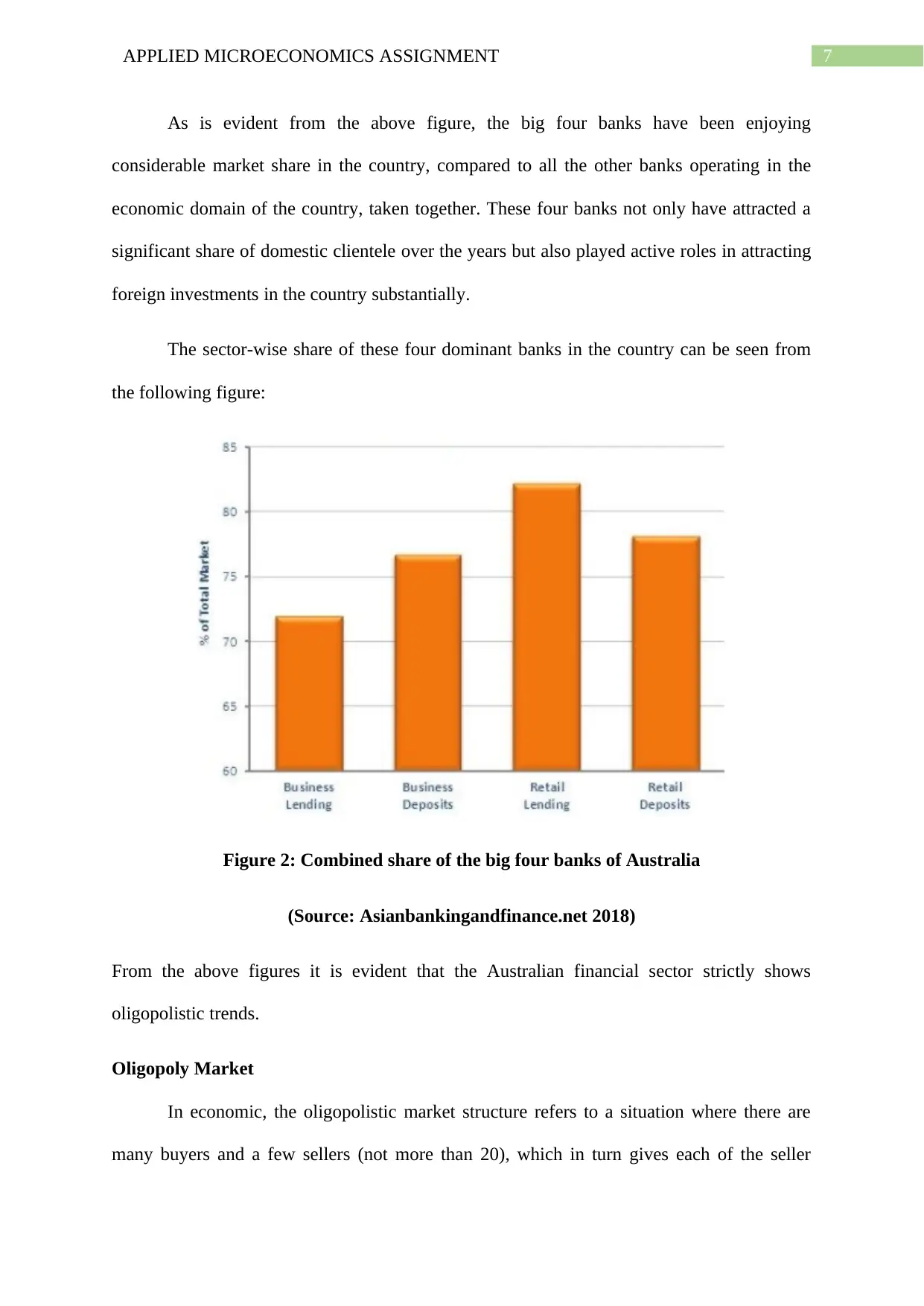
7APPLIED MICROECONOMICS ASSIGNMENT
As is evident from the above figure, the big four banks have been enjoying
considerable market share in the country, compared to all the other banks operating in the
economic domain of the country, taken together. These four banks not only have attracted a
significant share of domestic clientele over the years but also played active roles in attracting
foreign investments in the country substantially.
The sector-wise share of these four dominant banks in the country can be seen from
the following figure:
Figure 2: Combined share of the big four banks of Australia
(Source: Asianbankingandfinance.net 2018)
From the above figures it is evident that the Australian financial sector strictly shows
oligopolistic trends.
Oligopoly Market
In economic, the oligopolistic market structure refers to a situation where there are
many buyers and a few sellers (not more than 20), which in turn gives each of the seller
As is evident from the above figure, the big four banks have been enjoying
considerable market share in the country, compared to all the other banks operating in the
economic domain of the country, taken together. These four banks not only have attracted a
significant share of domestic clientele over the years but also played active roles in attracting
foreign investments in the country substantially.
The sector-wise share of these four dominant banks in the country can be seen from
the following figure:
Figure 2: Combined share of the big four banks of Australia
(Source: Asianbankingandfinance.net 2018)
From the above figures it is evident that the Australian financial sector strictly shows
oligopolistic trends.
Oligopoly Market
In economic, the oligopolistic market structure refers to a situation where there are
many buyers and a few sellers (not more than 20), which in turn gives each of the seller
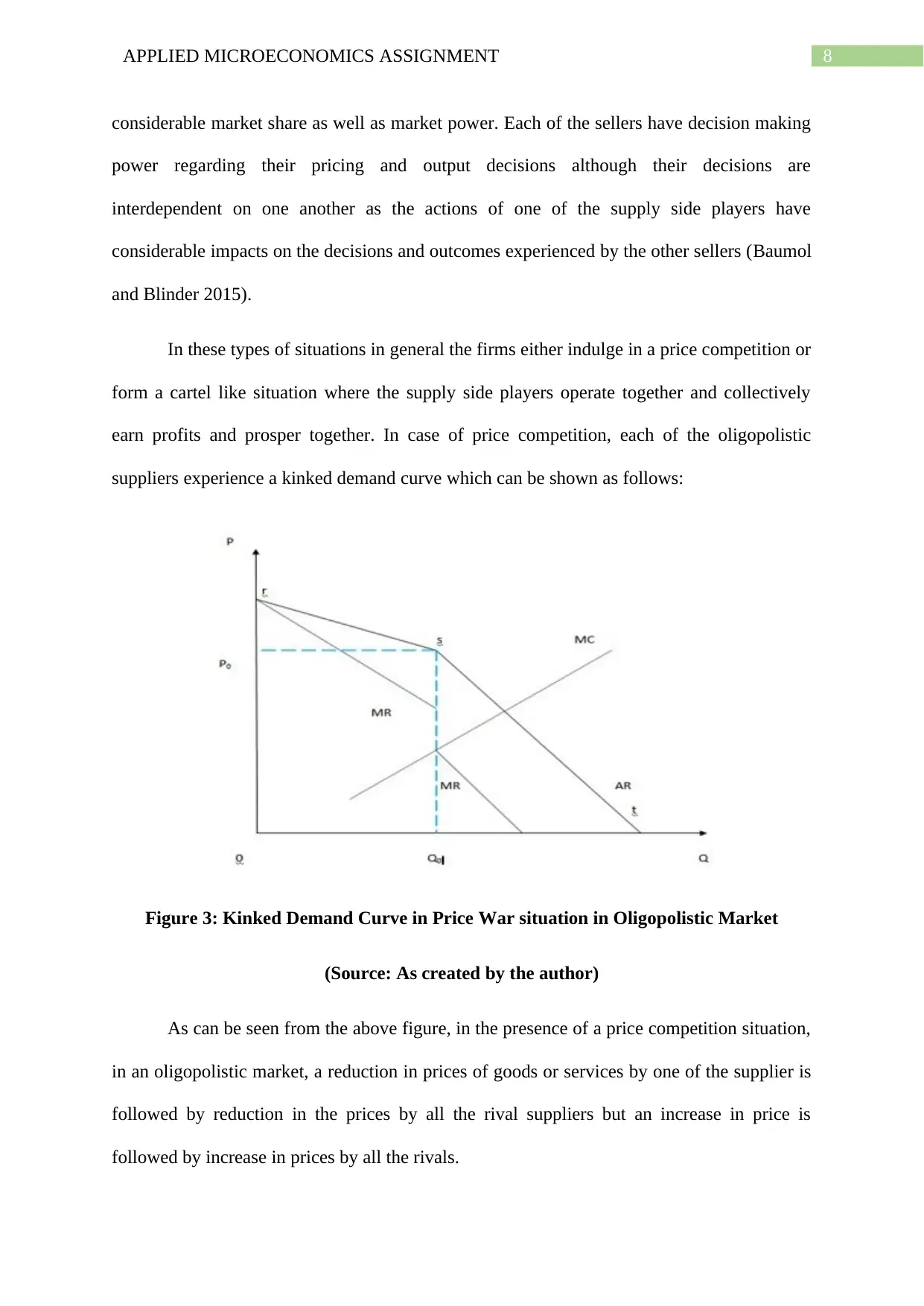
8APPLIED MICROECONOMICS ASSIGNMENT
considerable market share as well as market power. Each of the sellers have decision making
power regarding their pricing and output decisions although their decisions are
interdependent on one another as the actions of one of the supply side players have
considerable impacts on the decisions and outcomes experienced by the other sellers (Baumol
and Blinder 2015).
In these types of situations in general the firms either indulge in a price competition or
form a cartel like situation where the supply side players operate together and collectively
earn profits and prosper together. In case of price competition, each of the oligopolistic
suppliers experience a kinked demand curve which can be shown as follows:
Figure 3: Kinked Demand Curve in Price War situation in Oligopolistic Market
(Source: As created by the author)
As can be seen from the above figure, in the presence of a price competition situation,
in an oligopolistic market, a reduction in prices of goods or services by one of the supplier is
followed by reduction in the prices by all the rival suppliers but an increase in price is
followed by increase in prices by all the rivals.
considerable market share as well as market power. Each of the sellers have decision making
power regarding their pricing and output decisions although their decisions are
interdependent on one another as the actions of one of the supply side players have
considerable impacts on the decisions and outcomes experienced by the other sellers (Baumol
and Blinder 2015).
In these types of situations in general the firms either indulge in a price competition or
form a cartel like situation where the supply side players operate together and collectively
earn profits and prosper together. In case of price competition, each of the oligopolistic
suppliers experience a kinked demand curve which can be shown as follows:
Figure 3: Kinked Demand Curve in Price War situation in Oligopolistic Market
(Source: As created by the author)
As can be seen from the above figure, in the presence of a price competition situation,
in an oligopolistic market, a reduction in prices of goods or services by one of the supplier is
followed by reduction in the prices by all the rival suppliers but an increase in price is
followed by increase in prices by all the rivals.
⊘ This is a preview!⊘
Do you want full access?
Subscribe today to unlock all pages.

Trusted by 1+ million students worldwide
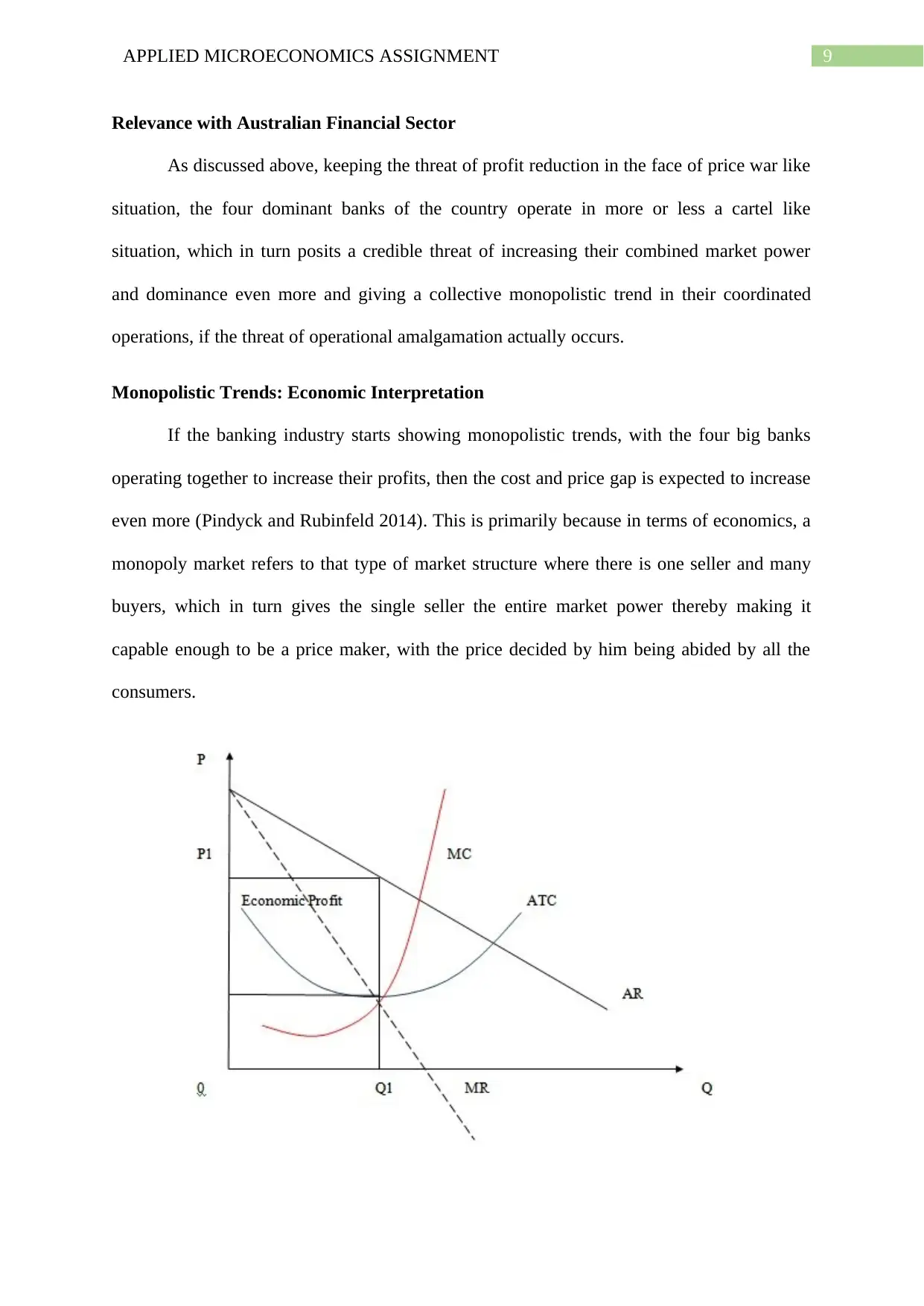
9APPLIED MICROECONOMICS ASSIGNMENT
Relevance with Australian Financial Sector
As discussed above, keeping the threat of profit reduction in the face of price war like
situation, the four dominant banks of the country operate in more or less a cartel like
situation, which in turn posits a credible threat of increasing their combined market power
and dominance even more and giving a collective monopolistic trend in their coordinated
operations, if the threat of operational amalgamation actually occurs.
Monopolistic Trends: Economic Interpretation
If the banking industry starts showing monopolistic trends, with the four big banks
operating together to increase their profits, then the cost and price gap is expected to increase
even more (Pindyck and Rubinfeld 2014). This is primarily because in terms of economics, a
monopoly market refers to that type of market structure where there is one seller and many
buyers, which in turn gives the single seller the entire market power thereby making it
capable enough to be a price maker, with the price decided by him being abided by all the
consumers.
Relevance with Australian Financial Sector
As discussed above, keeping the threat of profit reduction in the face of price war like
situation, the four dominant banks of the country operate in more or less a cartel like
situation, which in turn posits a credible threat of increasing their combined market power
and dominance even more and giving a collective monopolistic trend in their coordinated
operations, if the threat of operational amalgamation actually occurs.
Monopolistic Trends: Economic Interpretation
If the banking industry starts showing monopolistic trends, with the four big banks
operating together to increase their profits, then the cost and price gap is expected to increase
even more (Pindyck and Rubinfeld 2014). This is primarily because in terms of economics, a
monopoly market refers to that type of market structure where there is one seller and many
buyers, which in turn gives the single seller the entire market power thereby making it
capable enough to be a price maker, with the price decided by him being abided by all the
consumers.
Paraphrase This Document
Need a fresh take? Get an instant paraphrase of this document with our AI Paraphraser
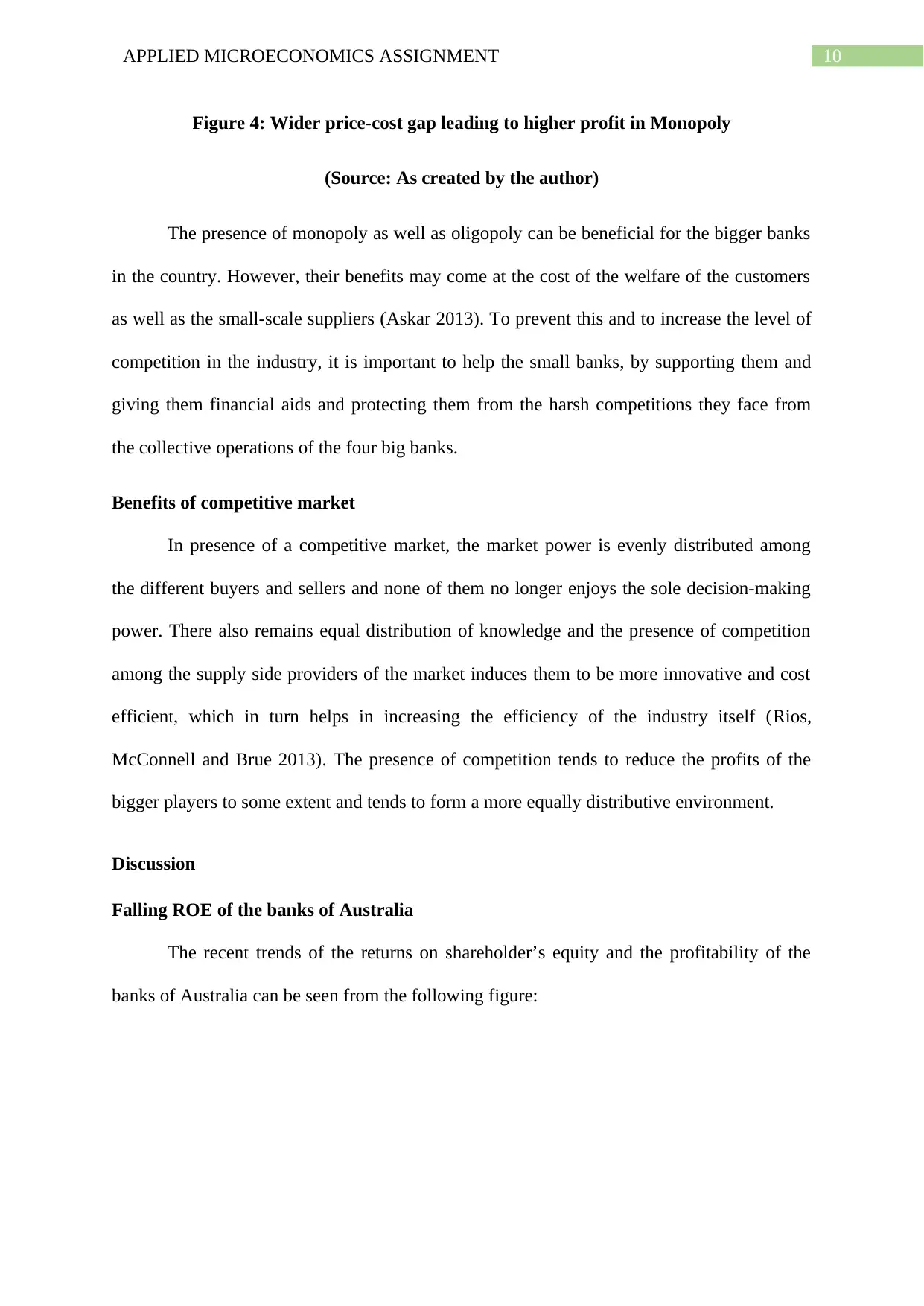
10APPLIED MICROECONOMICS ASSIGNMENT
Figure 4: Wider price-cost gap leading to higher profit in Monopoly
(Source: As created by the author)
The presence of monopoly as well as oligopoly can be beneficial for the bigger banks
in the country. However, their benefits may come at the cost of the welfare of the customers
as well as the small-scale suppliers (Askar 2013). To prevent this and to increase the level of
competition in the industry, it is important to help the small banks, by supporting them and
giving them financial aids and protecting them from the harsh competitions they face from
the collective operations of the four big banks.
Benefits of competitive market
In presence of a competitive market, the market power is evenly distributed among
the different buyers and sellers and none of them no longer enjoys the sole decision-making
power. There also remains equal distribution of knowledge and the presence of competition
among the supply side providers of the market induces them to be more innovative and cost
efficient, which in turn helps in increasing the efficiency of the industry itself (Rios,
McConnell and Brue 2013). The presence of competition tends to reduce the profits of the
bigger players to some extent and tends to form a more equally distributive environment.
Discussion
Falling ROE of the banks of Australia
The recent trends of the returns on shareholder’s equity and the profitability of the
banks of Australia can be seen from the following figure:
Figure 4: Wider price-cost gap leading to higher profit in Monopoly
(Source: As created by the author)
The presence of monopoly as well as oligopoly can be beneficial for the bigger banks
in the country. However, their benefits may come at the cost of the welfare of the customers
as well as the small-scale suppliers (Askar 2013). To prevent this and to increase the level of
competition in the industry, it is important to help the small banks, by supporting them and
giving them financial aids and protecting them from the harsh competitions they face from
the collective operations of the four big banks.
Benefits of competitive market
In presence of a competitive market, the market power is evenly distributed among
the different buyers and sellers and none of them no longer enjoys the sole decision-making
power. There also remains equal distribution of knowledge and the presence of competition
among the supply side providers of the market induces them to be more innovative and cost
efficient, which in turn helps in increasing the efficiency of the industry itself (Rios,
McConnell and Brue 2013). The presence of competition tends to reduce the profits of the
bigger players to some extent and tends to form a more equally distributive environment.
Discussion
Falling ROE of the banks of Australia
The recent trends of the returns on shareholder’s equity and the profitability of the
banks of Australia can be seen from the following figure:
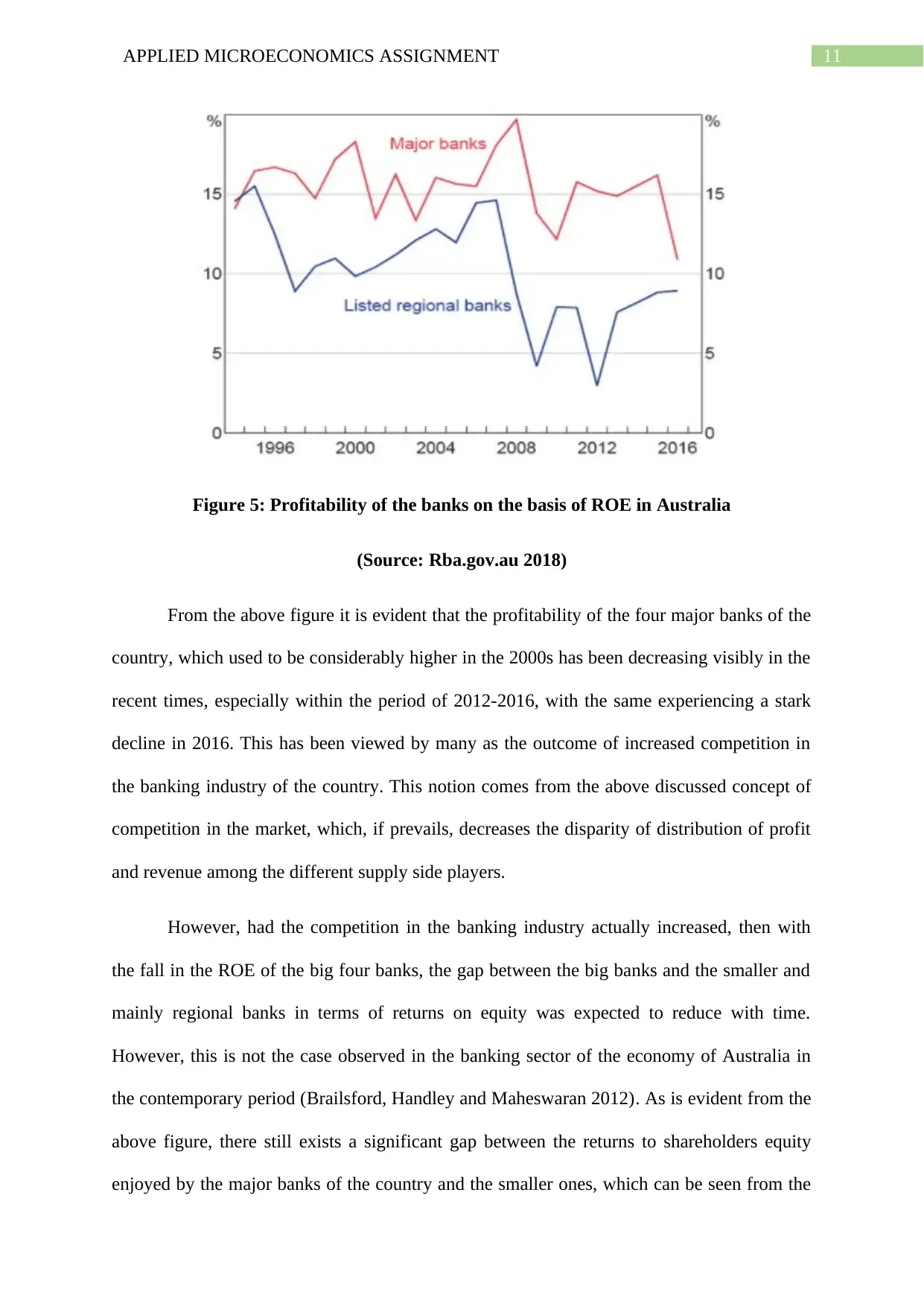
11APPLIED MICROECONOMICS ASSIGNMENT
Figure 5: Profitability of the banks on the basis of ROE in Australia
(Source: Rba.gov.au 2018)
From the above figure it is evident that the profitability of the four major banks of the
country, which used to be considerably higher in the 2000s has been decreasing visibly in the
recent times, especially within the period of 2012-2016, with the same experiencing a stark
decline in 2016. This has been viewed by many as the outcome of increased competition in
the banking industry of the country. This notion comes from the above discussed concept of
competition in the market, which, if prevails, decreases the disparity of distribution of profit
and revenue among the different supply side players.
However, had the competition in the banking industry actually increased, then with
the fall in the ROE of the big four banks, the gap between the big banks and the smaller and
mainly regional banks in terms of returns on equity was expected to reduce with time.
However, this is not the case observed in the banking sector of the economy of Australia in
the contemporary period (Brailsford, Handley and Maheswaran 2012). As is evident from the
above figure, there still exists a significant gap between the returns to shareholders equity
enjoyed by the major banks of the country and the smaller ones, which can be seen from the
Figure 5: Profitability of the banks on the basis of ROE in Australia
(Source: Rba.gov.au 2018)
From the above figure it is evident that the profitability of the four major banks of the
country, which used to be considerably higher in the 2000s has been decreasing visibly in the
recent times, especially within the period of 2012-2016, with the same experiencing a stark
decline in 2016. This has been viewed by many as the outcome of increased competition in
the banking industry of the country. This notion comes from the above discussed concept of
competition in the market, which, if prevails, decreases the disparity of distribution of profit
and revenue among the different supply side players.
However, had the competition in the banking industry actually increased, then with
the fall in the ROE of the big four banks, the gap between the big banks and the smaller and
mainly regional banks in terms of returns on equity was expected to reduce with time.
However, this is not the case observed in the banking sector of the economy of Australia in
the contemporary period (Brailsford, Handley and Maheswaran 2012). As is evident from the
above figure, there still exists a significant gap between the returns to shareholders equity
enjoyed by the major banks of the country and the smaller ones, which can be seen from the
⊘ This is a preview!⊘
Do you want full access?
Subscribe today to unlock all pages.

Trusted by 1+ million students worldwide
1 out of 19
Related Documents
Your All-in-One AI-Powered Toolkit for Academic Success.
+13062052269
info@desklib.com
Available 24*7 on WhatsApp / Email
![[object Object]](/_next/static/media/star-bottom.7253800d.svg)
Unlock your academic potential
Copyright © 2020–2025 A2Z Services. All Rights Reserved. Developed and managed by ZUCOL.





